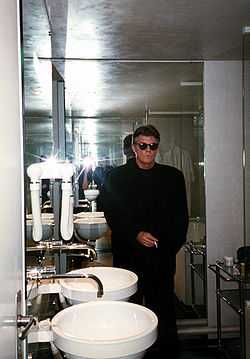Lewis Baltz
| Lewis Baltz | |
|---|---|
 Lewis Baltz in Jean Nouvel's Amat hotel. | |
| Born |
September 12, 1945 Newport Beach, California |
| Education |
San Francisco Art Institute Claremont Graduate School |
| Occupation | Artist |
| Known for | New Topography |
Lewis Baltz (born September 12, 1945) is a visual artist and well known photographer who became an important figure in the New Topographic movement of the late 1970s.[1]
Baltz graduated with a BA in Fine Arts from San Francisco Art Institute in 1969 and holds a Master of Fine Arts degree from Claremont Graduate School.[2] He received several scholarships and awards including a scholarship from the National Endowment For the Arts (1973, 1977), the John Simon Guggenheim Memorial Fellowship (1977),[2] US-UK Bicentennial Exchange Fellowship (1980), and Charles Brett Memorial Award (1991). In 2002 Baltz became a Professor for Photography at the European Graduate School in Saas-Fee, Switzerland.[1] He is now living in Paris and Venice.
His work is focused on searching for beauty in desolation and destruction. Baltz images describe the architecture of the human landscape, offices, factories, and parking lots.[2] His pictures are the reflection of control, power, and influenced by and over human beings. His minimalistic photographs in the trilogy Ronde de Nuit, Docile Bodies, and Politics of Bacteria, picture the void of the other. In 1974 he captured the anonymity and the relationships between inhabitation, settlement, and anonymity in The New Industrial Parks near Irvine, California (1974).
Baltz moved to Europe in the late 1980s and started to use large colored prints. Several books and articles featured his creations including Geschichten von Verlangen und Macht, with Slavica Perkovic (Scalo, 1986). Other photographic series, including Sites of Technology (1989–92), depict the clinical, pristine interiors of hi-tech industries and government research centres, principally in France and Japan.
His books and exhibitions, his "topographic work",[1] such as The New Industrial Parks, Nevada, San Quentin Point, Candlestick Point (84 photographs documenting a public space near Candlestick Park, ruined by natural detritus and human intervention), expose the crisis of technology and define both objectivity and the role of the artist in photographs.[citation needed]
The story Deaths in Newport was produced as a book and CD-Rom in 1995. His works have been presented in numerous exhibitions around the world, and appear in museums such as the Museum of Modern Art, Paris, Museum of Contemporary Art, Helsinki, San Francisco Museum of Modern Art and The Whitney Museum of American Art, New York.[citation needed] He writes for many journals, and contributes regularly to L'Architecture d'Aujourd'hui. Baltz has also worked a number of video works
References
- ↑ 1.0 1.1 1.2 Lewis Baltz Faculty Website at European Graduate School.
- ↑ 2.0 2.1 2.2 Jeff Rian (2001), Lewis Baltz, London: Phaidon, ISBN 0-7148-4039-4, OCLC 47677835, 0714840394
External links
- Lewis Baltz Faculty website at European Graduate School. (Biography, bibliography and articles)
- George Eastman House Lewis Baltz Series
- Oral history interview with Lewis Baltz, 2009 Nov. 15-17 from the Smithsonian Archives of American Art
|